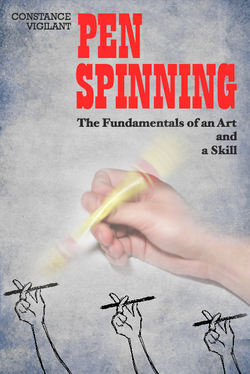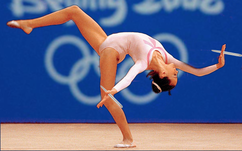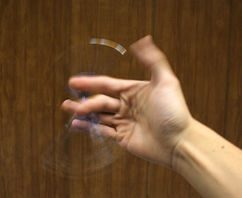User:MacMania/Pen spinning
Pen spinning is a competitive sport involving the manipulation of a stylus with the fingers and thumb of a hand—normally that of a human—combining elements of boredom, school or office supplies, and the fundamental human desire to waste time. Originating from the traditional performing arts of Imperial China, the sport has seen rapid expansion around the world in the last half-century. Pen spinning is currently governed worldwide by the International Organisation of Pen Spinning (PISO, since those French always get the initials wrong).
History[edit | edit source]
Pen spinning began as brush rotation, a variation on the ancient Chinese art of calligraphy. Whereas the calligrapher would create beautiful forms and letters and words with his brush, however, the brush rotator would simply spin it every which way he could as fast as possible. Hui Zhuan (回轉), the pioneer in this art, was said to have been able to spin his brush a dozen revolutions a second. Unfortunately, this many revolutions a second was deemed treasonous to the Imperial Court, and Hui Zhuan, like most good inventors in Imperial China, was put to death, and most of his records destroyed.[1]
Some of the records, however, appear to have survived, and traded to Japan for its Pot Noodles. With the Meiji Restoration, an influx of Western culture brought to the Japanese people styluses, biros and other types of pens. Kaiten Hitsu (筆回転), one of the few people in whom the secrets of brush rotation had survived, realised that pens were harder to break or leak ink, making possible more versatile moves and tricks. Few people know of Hitsu's influence in the modernisation of Japan, but it is evident in the original draft of the Five Charter Oath that began the process:
| “ | By this oath, we set up as our aim the establishment of the national wealth on a broad basis and the framing of a constitution and laws.
|
” |
Although this was later modified to exclude explicit mentions of pen spinning, the form nonetheless became a significant counter-productive activity for the public, lasting through both World Wars, US occupation, and numerous economic crises during which the only industry safe was the biro manufacturing industry.
Competitive pen spinning[edit | edit source]
Pen spinning competitions used to be held by ballpoint pen manufacturers as a marketing stunt to show how aerodynamically designed their pens were, which was, of course, of completely no necessity to the general public but nonetheless somehow a prominent selling point for the idiots, which is to say, 96.6 percent of the general public.
Pen spinning organisations have existed outside of biro companies; traditionally, in Japan the game is governed by the Japan Pen Spinning Association (日本ペン回し協会), which teaches and supports all referees, players, and the governing elders of the game, who are typically 20-30 years old.
However, with the Internet making unpopular fringe groups more popular than ever, pen spinning organisations have become of increasingly greater scale. Most are members of PISO, who supervise the international promotion and organisation of the sport. PISO have been able to successfully petition for the inclusion of pen spinning in certain prominent international sporting events, such as the Asian Games, the Commonwealth Games, the X Games (where it is dubbed "Extreme Pen Rotation"), and even the Summer Olympics (albeit as a demonstration sport).
In competitions, a pen spinner is judged by a combination of various factors, including but not limited to: the linear as well as angular speed of the spinning pen, the aesthetic quality of the spinning, the advanced nature of the moves performed, the number of pens,[2] and whether or not the competitor has misplaced the pen's lid.
Tricks[edit | edit source]
Basic manipulation[edit | edit source]
Four basic tricks are the basis for all of pen spinning:
- The ThumbAround™ (France Patent Nº 188042, held by Société Bic) is perhaps the most basic trick of all. It is done, as the name suggests, by pushing the pen around the thumb and allowing it to perform a full 360˚ revolution. The trick essentially goes nowhere and comes back full circle.
- The FingerPass™ (US Patent Nº 224298, held by Parker Pen Company) actually does go somewhere. The trick involves twirling the pen so that it passes through all four fingers. The trick was performed in the James Bond film GoldenEye, making 1995 the year that pen spinning's coolness died out.
- The Sonic involves moving the pen between finger positions as quickly as possible. The name comes from the extreme speed with which this trick must be performed, as well as references the quite a few gold rings that must be collected as the trick is performed.
- The Charge does not involve spinning the pen around any fingers or body parts; rather, it involves holding the pen like a homicidal maniac would a knife—lid uncovered, obviously—and charging like a mechanical bull at the nearest potential victim.



